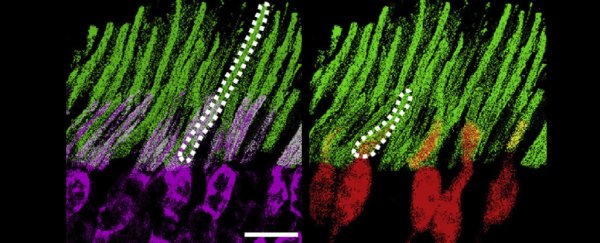An incredible new nanotechnology could one day enable us to see in the dark. It works on mice, and there's little to say it wouldn't be equally effective on other mammals. The only drawback - how are you with needles to the eyeball?
Research led by the University of Science and Technology of China produced particles that adhere to light-detecting cells in the retina and help them respond to near-infrared (NIR) wavelengths.
The back of our eye, which is where the retina is, acts like a television screen in reverse. As the full spectrum of light falls on its cells, some wavelengths trigger chemical reactions we perceive as either colour or intensity.
Rod-shaped cells tell our brain how bright it is. They react strongly to light waves around 500 nanometres in size, but struggle to respond to anything above 640 nanometres, well into the red part of the spectrum.
We also have three types of tapering 'cone' shaped photoreceptor cells, each sensitive to their own parts of the spectrum. Combined, they provide our brains with the detail needed to tell colours apart.
But those cones also fail to detect light longer than around 700 nanometres, which means anything beyond the red part of the spectrum is completely invisible to us.
That's a shame. What looks like darkness to us is often washed in low-energy, low wavelength parts of the spectrum. A number of animals, such as snakes and frogs, have evolved ways to tap into these wavelengths to track prey or see better at night.
Unfortunately mammals never managed to evolve what it takes to see even the edge of this infra-red spectrum. We humans have it relatively lucky. Mice only have rods and two types of cone cells, which all top out at wavelengths a little under ours.
There are quirks of chemistry that can help us glimpse a flash of NIR light, but generally speaking, an infra-red landscape is strictly off limits to us humans.
Bulky night vision goggles can capture this radiation and amplify it in wavelengths we can see, but wearing such tech is cumbersome and it can't be used under daylight conditions.
The nanoparticles developed by the researchers in this latest innovation act like miniature night vision devices - only these ones sit directly on the actual light-sensitive cells.
Called retinal photoreceptor-binding upconversion nanoparticles, they're a protein built to adhere to both rod and cone photoreceptors and transduce long wavelengths into shorter ones.
The result is a nanoscale device that acts like a tiny antenna, soaking up invisible NIR radiation and turning it into a colour that is more likely to trigger rods and cones into action, painting the world in hues of green.
Injected into mice, the whole process seems to work brilliantly. The nanoantennae were shown to not only stick to photoreceptors, but an LED shining weakly at 980 nanometres elicited retinal responses that were demonstrated to affect the brain's visual cortex.
In a more practical experiment, the treated mice were able to differentiate simple shapes such as triangles and circles illuminated by the LED under various conditions. Best of all, they were still able to see just fine under normal daylight conditions.
The vision change didn't come with awful side effects either. The only issue the team found was cloudiness in the eyes of the mice.
The mouse visual system is similar enough to humans that we might expect a version of this method could potentially work for us, too. In fact, there's even a weird sort-of precedent.
A few years ago, biohackers rigged a similar process using a light sensitive substance called Chlorin e6 to make the retina generally more sensitive to light. Applied as eye drops, subjects could allegedly see longer distances under low light conditions.
Whether this promises genuine technology or was simply an overhyped experiment is up for debate. Eye drops would certainly be better than an injection into the eyeball, but this new nanotechnology has far more rigorous science to back it up.
It's not hard to come up with cool uses for such tech. Military applications aside, who wouldn't want to see better at night? Astronomers, for one.
"We may have the capability to view all the hidden information from NIR and IR radiation in the Universe which is invisible to our naked eyes," says biochemist Gang Han from the University of Massachusetts Medical School.
But there are also serious research benefits in the form of experimental tools that can investigate visual processes on new levels.
"With this research, we've broadly expanded the applications of our nanoparticle technology both in the lab and translationally," says Han.
"These nanoantennae will allow scientists to explore a number of intriguing questions, from how the brain interprets visual signals to helping treat colour blindness."
This research was published in Cell.
